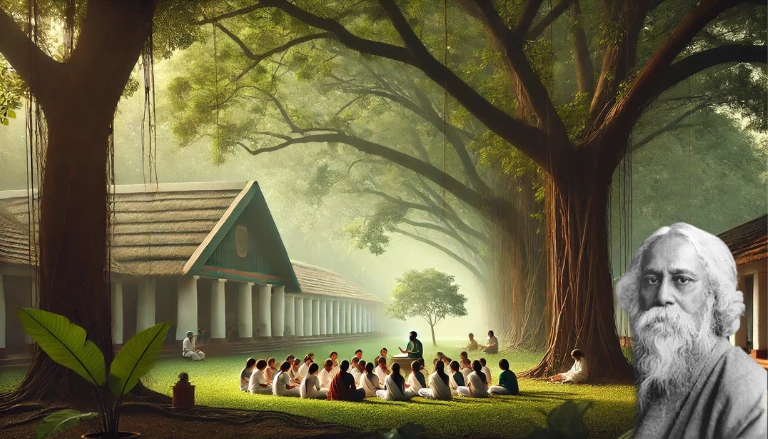Rabindranath Tagore, the Nobel Prize-winning poet, writer, and philosopher, is celebrated for his deep connection with nature, which significantly influenced his works and vision for education. His establishment of Shantiniketan, which later became Visva-Bharati University, was not only a center of learning but also a sanctuary where students and teachers lived in harmony with nature. This article explores the symbiotic relationship between Tagore, Shantiniketan, and the natural environment, revealing how nature shaped his thoughts, writings, and the unique education model he developed.
Rabindranath Tagore: The Poet of Nature 🌿
Rabindranath Tagore’s life and work were deeply intertwined with nature. Born in 1861 in Kolkata, Tagore often sought refuge in the peaceful surroundings of nature, whether in the gardens of his family home or during his travels across India and abroad. His poetry, songs, and stories frequently reflect his admiration for the natural world, and he viewed nature as a source of beauty, tranquility, and wisdom.
Tagore’s literary works, including Gitanjali, contain vivid imagery of the changing seasons, the beauty of the natural landscape, and the profound peace one finds in nature. His connection to nature was not just aesthetic but spiritual, as he believed that the natural world was a reflection of the divine.
Shantiniketan: A Vision Rooted in Nature 🌞
Shantiniketan, which means “Abode of Peace,” was founded by Tagore’s father, Maharshi Debendranath Tagore, as a meditation retreat. However, it was Rabindranath Tagore who transformed it into an educational institution where nature played a central role. Tagore’s vision for Shantiniketan was grounded in the idea that education should not be confined to the four walls of a classroom but should be an immersive experience in nature. He believed that students should learn under the open sky, surrounded by trees, fields, and rivers.
Nature as a Classroom 🌳
Tagore’s educational philosophy was revolutionary. In his model, students were encouraged to sit under the shade of trees during lessons, allowing them to develop a closer connection to the environment. Tagore believed that this harmonious relationship with nature would foster creativity, curiosity, and emotional well-being in students.
This concept of learning in nature was central to Tagore’s idea of holistic education. He believed that the best way to cultivate the mind and soul was to let students experience the beauty of the natural world, drawing inspiration from it rather than following rigid, conventional teaching methods. The environment of Shantiniketan was carefully maintained to reflect these values, with open-air classrooms and an emphasis on arts and creativity, all set against the backdrop of nature.
Nature’s Influence on Tagore’s Works 🍃
Nature is a recurrent theme in Tagore’s literary works. In his famous collection Gitanjali, which won him the Nobel Prize for Literature in 1913, Tagore frequently invokes images of rivers, skies, seasons, and the earth. His poems often reflect the idea that nature is a source of solace and spiritual renewal.
For instance, in his poem “Where the Mind is Without Fear,” Tagore envisions a world where freedom and knowledge flow like the natural rivers, unrestricted by boundaries. The themes of unity and peace, which are prominent in his writings, are often tied to the harmony he found in nature.
The Environmental Legacy of Shantiniketan 🌱
Tagore’s vision of Shantiniketan as a model of sustainable living and learning continues today. Visva-Bharati University, which evolved from Shantiniketan, still maintains its core principles of environmental consciousness. The institution regularly hosts workshops, festivals, and cultural programs that celebrate the relationship between humans and the environment, reflecting Tagore’s original ideals.
Shantiniketan is known for its extensive green spaces, groves of trees, and gardens, which serve as a reminder of Tagore’s belief that education should be a lifelong interaction with nature. His legacy lives on in the students who continue to study and engage with the natural world in the very setting he designed.
Nature as the Ultimate Teacher 🌿
For Rabindranath Tagore, nature was more than just a backdrop—it was the essence of life, learning, and spiritual growth. His creation of Shantiniketan was a testament to his belief in the healing, nurturing power of the natural world. Through his writings, teachings, and educational philosophy, Tagore left behind a legacy that continues to inspire us to live harmoniously with nature.
By encouraging future generations to embrace the beauty of the world around them, Tagore has ensured that his vision for a holistic, nature-centered approach to learning remains relevant today. Shantiniketan stands as a living monument to this vision, inviting people from all walks of life to reconnect with nature, learn from it, and find peace within it.
Discover more from Green Ecosystem - Renewable Energy, Agriculture, and Environmental Sustainability
Subscribe to get the latest posts sent to your email.


